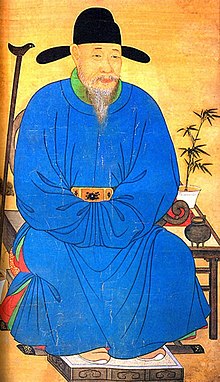
Back يونغيجونغ Arabic Yeonguijeong ID 領議政 Japanese 영의정 Korean Yeonguijeong Malay ย็องอีจ็อง Thai Йонийджон Ukrainian Lãnh nghị chính VI 領議政 Chinese 領議政 ZH-CLASSICAL
| Yeonguijeong | |
 Portrait of Ha Yeon who served as Yeonguijeong during King Sejong's reign. | |
| Korean name | |
|---|---|
| Hangul | 영의정/영상/상상/수규/원보 |
| Hanja | |
| Revised Romanization | yeong-uijeong[1]/ sangsang/ sugyu/ wonbo |
| McCune–Reischauer | yŏng'ŭijŏng/sangsang/sukyu/wonbo |

The Yeonguijeong (Korean: 영의정; Korean pronunciation: [jʌŋ.ɰi.dʑʌŋ]) or Chief State Councilor was a member of the Uijeongbu and the highest government position in Joseon Korea.[1][2] The Yeonguijeong held roles similar to a modern-day prime minister of a presidential system.[3] As the senior member of the Chief State Council, the Yeonguijeong participated in the administration of general government affairs alongside the Jwauijeong and Uuijeong.
The title was created in 1400 with the creation of the Uijeongbu. Existing for over 500 years, the function was handed over in 1895 during the Gabo Reform to the newly formed position of the Prime Minister of Korea.[4][3] Only one official, usually an elder who had previously served as Jwauijeong, was allowed to assume the position of Yeonguijeong. The Yeonguijeong was referred to as Yeongsang (영상; 領相; lit. leading minister of state), Sangsang (상상; 上相; lit. upper minister of state), Sugyu (수규; 首揆; lit. head premier) or Wonbo (원보; 元輔; lit. primary assistant).[3]
Although the title of Yeonguijeong was legally defined as the highest post in charge of all state affairs, its practical roles and powers shifted drastically throughout history as the roles of the Uijeongbu were not clearly defined in the Gyeongguk daejeon. During the early years of Joseon, the Yeonguijeong saw limited roles in government as the Six Ministries reported directly to the king.
- ^ a b "영의정(領議政 ), yeong-uijeong" (in Korean and English). The Academy of Korean Studies. Archived from the original on September 27, 2011. Retrieved 2009-01-29.
- ^ Choi (2006), The Origin of the Roman Catholic Church in Korea p. 375
- ^ a b c 영의정 (領議政). Encyclopedia of Korean Culture (in Korean). Retrieved August 21, 2024.
- ^ 영의정 (in Korean and English). Daum Korean-English Dictionary.